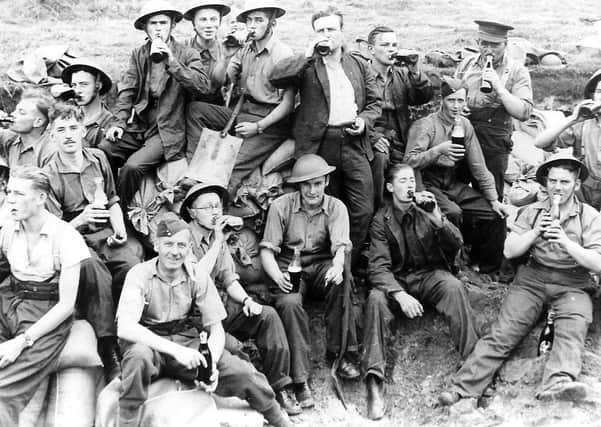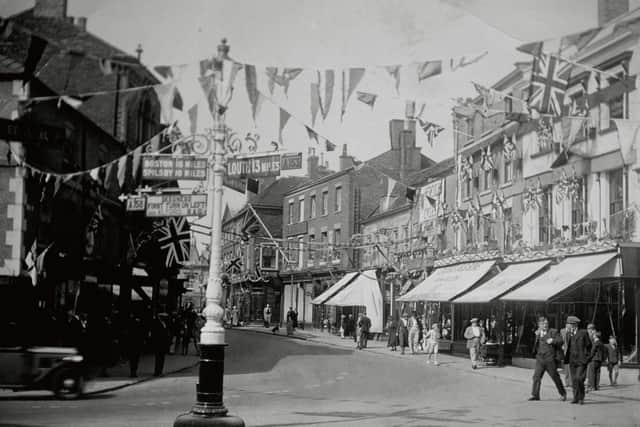Looking back at VE Day: The day Horncastle celebrated - and like never before!


By some means or other, news got round that the prime minister was to announce the end of hostilities at 3 o’clock, and everybody gathered with tense expectation round wireless sets.
When the usual programme went on and no announcement came, people gradually drifted back to their ordinary labours, although they sensed there was something ‘in the air’.
Advertisement
Hide AdAdvertisement
Hide AdA few flags appeared in the street fluttering shyly in the breeze - wondering if they were too soon.


When the announcement finally came on the evening wireless that Tuesday would officially be VE Day, and Tuesday and Wednesday would be national holidays, the spirit of joy was soon apparent everywhere.
Householders made hurried preparations with their streamers and flags.
Very quickly on Tuesday morning, Horncastle was adorned with bunting.
Advertisement
Hide AdAdvertisement
Hide AdUnion Jacks were flying gaily from almost every house and the display of colour made a brave show, despite the difficulty of obtaining flags.
Every street was decorated and the narrow parts of High Street and West Street, lending themselves to the ranging of streamers were particularly noticeable, as was North Street.
For a time, the Market Square stood out in its bareness, but after a hesitating start, the urban council and its officials rose to the occasion splendidly.
In the short time available, they arranged a programme which would give people an opportunity of showing their joy in a way they wished.
Advertisement
Hide AdAdvertisement
Hide AdThe Market Square was chosen as the centre for the town’s festivities and soon the surveyor and his men had streamers swinging from the Monument to the trees, while coloured lamps showed that there were to be illuminations after dark.
In the afternoon, the prime minister’s ‘cease fire’ declaration was heard through loud speakers erected on the Market Place.
Mr J. T. Friskney, chairman of the urban council, spoke a few words to the crowd. Music from Mr Robinson’s panatrope followed.
In the morning and at intervals during the day, the bells of St Mary’s rang out a merry peal and the staff of the LNER Station made everyone jump with fog signals.
Advertisement
Hide AdAdvertisement
Hide AdThe vicar arranged an early celebration of Holy Communion at St Mary’s, and three short services of thanksgiving. All were well attended.
Evening came and everybody wended their way to the Market Place.
The spirit of festivity reached its highest pitch, and the joyous celebrations became general.
All Horncastle was there – adults, boys and girls and children danced and frolicked amidst joy and laughter under the stream of coloured lamps and in the glare of the floodlighting, provided by Mr Dobbs, until after midnight – and kept it up continually except for a brief pause to hear the king.
Advertisement
Hide AdAdvertisement
Hide AdIt was a well-behaved and sober, yet happy, crowd that danced round and round the Stanhope Memorial.
Mr J. H. Morris, vice-chairman of the council, assisted with the announcements, and when he asked at about 11 o’clock ‘if it is time to go to bed’ the crowd quickly set his mind at rest with a unanimous ‘No, carry on!’ with never a thought for sore feet and tired limbs.
Midnight chilled and it was a quarter of an hour later when the last waltz came, and Horncastle ceased dancing and went home to bed, after expressing their loyalty with the National Anthem.
Some, however, stayed out longer. Those passing along West Street on their way home suddenly came into the glare of floodlighting, and people dancing.
Advertisement
Hide AdAdvertisement
Hide AdHere, Mr. B. V. Clover had erected, on a cable across the street from his residence, a brilliant electric light.
He was providing popular dance tunes on his gramophone.
The temptation to dance was too great. Sore feet and tiredness were forgotten, and it was 2 o’clock in the morning before the crowd would go home, to end a joyous day.
The weather was favourable. A thunderstorm on Tuesday after a sunny morning raised doubts, but the storm cleared after a heavy deluge and the rest of the day and Wednesday were warm and sunny.
The Drill Hall was packed for the Victory Dance on Wednesday evening. Wednesday was another general holiday in the town – no shops were open.
Advertisement
Hide AdAdvertisement
Hide AdOn Thursday morning Horncastle returned to work, its people ready to play their part in building the better world for which so many had died.
Editor’s note: The Horncastle News would like to thank Horncastle History and Heritage Society for all the information supplied for the VE Day articles.
History society to the rescue on VE Day
Organisations across Horncastle had major plans to celebrate the 75th anniversary of VE Day on May 8...but the Covid-19 lockdown has meant everything has had to be shelved.
Members of Horncastle History and Heritage Society were not deterred and decided to create a virtual exhibition online.
Advertisement
Hide AdAdvertisement
Hide AdWith the help of donations of photographs and memories of local people, the society has created a virtual exhibition to share stories of how VE Day was celebrated in Horncastle - and the town in wartime.
Thanks to permission from its current publishers JPIMedia, the exhibition reproduces an original article from the Horncastle News back in 1945, recording how the town celebrated with dancing in the street until after 2am.
There are also memories from a few of the handful of residents who today are in their 90s and still remember that celebratory day.
The exhibition also charts the issues faced on the home front during the war like blackouts, rationing and taking in evacuees.
Advertisement
Hide AdAdvertisement
Hide AdNewspaper reports and first-hand accounts have also been used to reveal the story of the ‘Horncastle Blitz’.
Over 50 bombs were dropped on the town over two days in September 1940.
More than 80 houses were damaged and several people were injured, but thankfully no-one was killed.
Dr Ian Marshman, chairman of the society, said: “It would have been a real shame to let this important anniversary pass completely unmarked because of coronavirus.
Advertisement
Hide AdAdvertisement
Hide Ad“Preparing this exhibition has been a big reminder of how hard life was in Horncastle during WWII. It’s no wonder they wanted to celebrate.”
The exhibition has also tried to pull together information on all the Horncastle soldiers who made the ultimate sacrifice in the conflict, with a virtual roll of honour. Photographs donated by people have made it possible to put a face to some of those named on the town’s war memorial.
• The website will be launched this Friday (May 8), making it possible for anyone to discover Horncastle’s wartime history.
Click here to find out more.